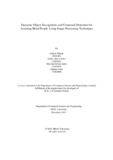| dc.contributor.advisor | Alam, Dr. Md. Ashraful | |
| dc.contributor.author | Tahsin, Labeba | |
| dc.contributor.author | Nuba, Nadia Ahlam | |
| dc.contributor.author | Sami, Mashiat ferdous | |
| dc.contributor.author | Afrin, Sabrina | |
| dc.date.accessioned | 2020-10-28T04:24:45Z | |
| dc.date.available | 2020-10-28T04:24:45Z | |
| dc.date.copyright | 2019 | |
| dc.date.issued | 2019-12 | |
| dc.identifier.other | ID: 19241031 | |
| dc.identifier.other | ID: 15301031 | |
| dc.identifier.other | ID: 15301094 | |
| dc.identifier.other | ID: 15301098 | |
| dc.identifier.uri | http://hdl.handle.net/10361/14070 | |
| dc.description | This thesis is submitted in partial fulfillment of the requirements for the degree of Bachelor of Science in Computer Science, 2019. | en_US |
| dc.description | Cataloged from PDF version of thesis. | |
| dc.description | Includes bibliographical references (pages 28-30). | |
| dc.description.abstract | Human senses are the only medium to communicate with environment. Our brain makes a
combination of different senses and convert it into a meaningful mixture. We, humans have
five different senses as in two eyes to see, one nose to smell, two ears to hear, one tongue to
taste and a skin to feel touch. All of these senses are connected deeply with each other. One
sense always has the backup of another one. There are thousands of people in the whole world
who are blind. They face many kinds of hindrances in their everyday life. They suffer badly in
travelling here and there like shopping, work, educational institutions and so on due to their
problem in sight. Hence, many papers have been published on making blind or visually
impaired people’s navigation easier. Different papers proposed different methods and different
ways to navigate their way. Our paper aims to represent a proposed system that helps a visually
impaired, which detects various objects and finds right path for them to reach to their
destination. Our projected model is mainly based on a well-known object detect and identifier
algorithm that needs to be trained by a dataset. Step by step, simulations using dynamic object
detection algorithm results in a better accuracy to detect those objects in our proposed model.
Hereby, our paper presents the idea of an object detection system based on object extractions;
networks for segmentations match with the recognized dataset and locate those objects from
the live video-image extractions, which gives an audio output. | en_US |
| dc.description.statementofresponsibility | Labeba Tahsin | |
| dc.description.statementofresponsibility | Nadia Ahlam Nuba | |
| dc.description.statementofresponsibility | Mashiat ferdous Sami | |
| dc.description.statementofresponsibility | Sabrina Afrin | |
| dc.format.extent | 30 pages | |
| dc.language.iso | en_US | en_US |
| dc.publisher | Brac University | en_US |
| dc.rights | Brac University theses are protected by copyright. They may be viewed from this source for any purpose, but reproduction or distribution in any format is prohibited without written permission. | |
| dc.subject | Objects detection | en_US |
| dc.subject | Blind people | en_US |
| dc.subject | Visually impaired | en_US |
| dc.title | Dynamic object recognition and command detection for assisting blind people using image processing techniques | en_US |
| dc.type | Thesis | en_US |
| dc.contributor.department | Department of Computer Science and Engineering, Brac University | |
| dc.description.degree | B. Computer Science | |

